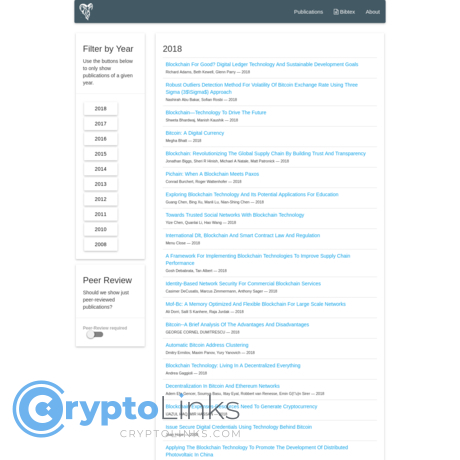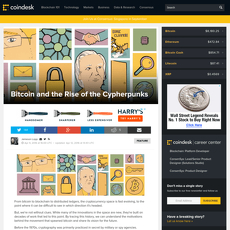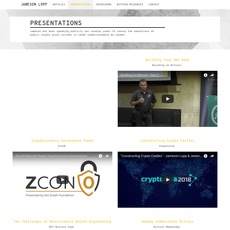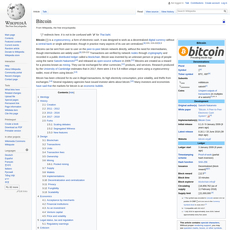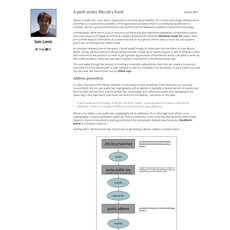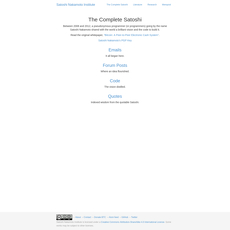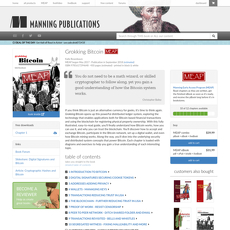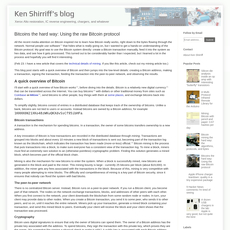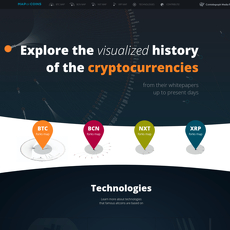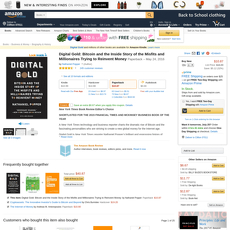btcresearch Review
btcresearch
cdecker.github.io
btcresearch Review Guide: Everything You Need to Know About Christian Decker’s Bitcoin Research Index
Ever wished you could find serious Bitcoin research without 12 tabs, paywalls, and dead ends? If you build, trade, research, or just want signal over noise, you’ve probably felt the pain of hunting for credible papers. I’m going to show you a faster way to get to the good stuff using btcresearch—but first, let’s be honest about why this is so hard.
The problem: scattered papers, sketchy sources, and endless search
Keeping up with Bitcoin research shouldn’t feel like archaeology. Yet most of us end up juggling arXiv links, conference PDFs, GitHub gists, blog posts, and publisher pages—only to discover we’ve saved duplicates, outdated versions, or clickbait summaries that miss the core idea.
- Fragmented sources: Key papers live across arXiv, IEEE/ACM proceedings, IACR ePrint, university pages, and personal sites. Some vanish. Others move.
- Version confusion: You’ll find a preprint on arXiv, slides from a workshop, and a final version in a conference—each with different pagination and citations.
- Paywalls: Publisher links (think IEEE Xplore or Springer) often lock you out. The open version exists—but you have to know where to look.
- SEO noise: “Top 10 Bitcoin research” posts often recycle the same old links or mix solid work with unreviewed claims.
- Topic drift: Try searching “mempool models” or “routing in Lightning” and you’ll get a soup of unrelated blockchain content or vendor whitepapers.
Real-world example: When I looked into efficient transaction relay (think “Erlay”), I found slides, preprints, and the peer-reviewed version spread across multiple sites. It took longer to verify the right citation path than to read the abstract.
Now multiply that by fee dynamics, privacy techniques, channel security, and consensus research. No wonder most people give up or settle for someone else’s summary.
The promise: a trusted, curated Bitcoin research hub
btcresearch cuts through the mess by giving you a clean, Bitcoin-first index curated by someone who actually works in the field. It’s designed for builders and researchers who want to scan by topic, jump to the right source, and get on with their work—without babysitting a hundred bookmarks.
In plain terms: you get a credible map of the territory. No spam. No filler. Just Bitcoin and Lightning research with clear labels so you can decide what’s worth your time.
What this review covers
I’ll walk you through how to get real value from btcresearch in minutes—not hours. Here’s what you’ll walk away with:
- What btcresearch is, who runs it, and why that matters for credibility.
- How it’s organized so you can find the right paper fast (including Lightning topics).
- Practical search and filtering tips to avoid rabbit holes.
- How to judge paper quality at a glance using authors, venues, and versions.
- When to use other tools if you need exhaustive coverage or citation graphs.
- A simple, repeatable workflow you can run in every research session—and a quick checklist you can use right away on Cryptolinks.com/news.
Ready to see what btcresearch actually is, who’s behind it, and how it stays useful without the fluff? Let’s answer that next.
What btcresearch is (and who’s behind it)
btcresearch is exactly what I wish more “crypto resources” tried to be: clean, focused, and built by someone who actually works on the hard problems. It’s a curated index of Bitcoin-first academic and technical papers, maintained by Christian Decker—one of the most consistent contributors to Bitcoin and Lightning research and engineering over the past decade.
“Signal beats noise when you know where to look.”
When I need credible, no-drama reading that moves the conversation forward, I start here. It’s not a random blogroll or a keyword-stuffed directory. It’s a living list that tracks where serious research is happening and where the protocol is headed.
Scope and focus: Bitcoin and Lightning first
The collection revolves around core Bitcoin topics and the adjacent work that actually matters to real-world use:
- Consensus and networking: transaction relay, block propagation, network topology, security assumptions
- Fees and incentives: mempool behavior, fee estimation, miner incentives, MEV-relevant edges as they touch Bitcoin
- Privacy and security: network-level privacy, wallet heuristics, script design, channel attacks
- Lightning Network: routing, channel management, reliability, liquidity, jamming resistance, payment success
Real-world examples you’ll typically find linked:
- The Lightning Network paper by Poon & Dryja — the starting point for off-chain scaling and channel mechanics
- Erlay (Naumenko et al., CCS) — a protocol for more efficient transaction relay to cut bandwidth while preserving fast propagation
- Payment path optimization on Lightning (Pickhardt/Richter and follow-on work) — improving reliability and cost of multi-part payments
- Network privacy studies (e.g., Dandelion/Dandelion++ and Bitcoin-focused analyses) — how transactions spread and how to reduce linkability
- Channel safety and jamming research — papers modeling griefing vectors, congestion, and force-close incentives
It’s Bitcoin-first by design. Broader cryptography or P2P research shows up when it’s relevant to Bitcoin’s actual constraints and tradeoffs, not because a keyword matches.
Maintainer and transparency
The list is maintained by Christian Decker and published openly on GitHub Pages. That matters for two reasons:
- Proven expertise: Decker’s track record on Bitcoin networking and Lightning (including work on eltoo/ANYPREVOUT proposals and Core Lightning engineering) gives the curation real signal.
- Public change history: You can see how the list evolves, what’s been added, and when. The project’s public footprint (e.g., GitHub) makes it clear this isn’t a black box.
I like that it feels community-minded without being crowdsourced chaos. It’s stewarded, but not closed off.
What each entry usually includes
Entries are practical and consistent, which makes scanning fast:
- Title and authors — quickly spot familiar names and collaborations
- Venue and year — conferences/journals (or arXiv) to gauge review level and recency
- Topic tags — anchors like privacy, fees, routing, incentives, security
- Direct link — usually to arXiv or the publisher’s page; many are free to read
Open an entry like “Erlay” and you’ll hit the publisher or arXiv page with PDF, BibTeX, and version history. If you live in a reference manager, that’s gold—no hunting around for citation data.
How it fits into your research stack
I use btcresearch as the “trust filter” before I go wide with academic databases:
- Discovery: Find the core set of papers on a topic without trawling junk search results.
- Credibility check: Venue and author info help me prioritize what to read now vs. later.
- Source of truth: Click through to the original publisher or preprint for the latest version, citations, and BibTeX.
- Context builder: Tags cluster related work so I can map out a topic in 10 minutes instead of a full afternoon.
It’s the shortest path from “I need to understand this” to “I’m reading the right three papers.”
Want to get from zero to a tight reading list in minutes? Up next, I’ll show you the quick ways to search, skim, and triage so you don’t get stuck in 30 open tabs. Which topic are you chasing first—fees, Lightning routing, or network privacy?
How to use btcresearch efficiently
“Signal beats noise when you know where to look — and when to stop looking.”
I use btcresearch to cut through clutter fast. Here’s the exact playbook I follow to go from zero to a tight, high-signal reading list in minutes.
Start with simple search and topical browsing
Two quick ways to find what you need: use the site’s built-in search (and your browser’s Ctrl/Cmd + F) or skim by major sections. I always start broad, then narrow.
- Lightning routing: search “routing,” “multi-path,” or “payment splitting.” You’ll spot work like flow-based routing approaches (e.g., the well-known “Pickhardt payments” direction) that’s become a go-to reference in the community. For context, see the style of research exemplified at arXiv:2107.05322.
- Network efficiency: search “relay,” “Erlay,” or “transaction propagation.” Papers such as Erlay (2019) are exactly the kind of credible network-layer improvements you want to benchmark.
- Privacy: search “Dandelion,” “Dandelion++,” “transaction origin,” or “anonymity.” A canonical example is Dandelion++, widely cited for P2P-layer privacy.
- Fees and mempool: try “mempool,” “RBF,” “CPFP,” “fee market,” or “incentives.” This quickly maps you to fee dynamics and miner-incentive literature.
- Lightning security: search “jamming,” “HTLC,” “watchtower,” or “revocation.” You’ll uncover attack-and-defense papers that inform real operational decisions.
- Protocol core topics: search “consensus,” “selfish mining,” “fork choice,” or “UTXO” to surface foundational research that underpins almost every other discussion.
Pro tip: Open 6–10 promising titles in new tabs right away. The quick side-by-side comparison helps you spot patterns, avoid duplicates, and keep only the strongest contenders.
Use tags, years, and venues to narrow fast
Don’t read yet — filter first. Tags, years, and venues are your quality radar.
- Tags: If your query is “Lightning jamming,” keep only entries tagged with Lightning/payment channels or closely related security topics.
- Years: Need state-of-the-art? Filter for the most recent 1–3 years to catch the latest iterations and follow-up work.
- Venues: Conferences like IEEE S&P, USENIX Security, ACM CCS, and Financial Cryptography usually signal rigorous review. When I’m short on time, I prioritize these first.
Why scan before reading? User-behavior research (see Nielsen Norman Group’s F‑pattern) shows we scan titles and headings first; using that bias intentionally speeds up triage without missing the good stuff.
Read the metadata like a pro
Strong metadata equals quick confidence. Here’s what I watch:
- Authors you recognize: Names like Decker, Poon, Dryja, Gervais, Naumenko, Miller, Narayanan (and frequent collaborators) are helpful signals in Bitcoin/LN domains.
- Venue clarity: “arXiv preprint” is fine for cutting-edge, but if there’s a final version at a known conference/journal, favor it for citations and polished results.
- Link destination: arXiv is great for open access. Publisher links may have paywalls, but often the preprint is one click away on btcresearch.
- Recency and lineage: Newer papers often reference or extend earlier classics; skimming related work sections helps you map the field quickly.
Green flags: consistent author affiliations, clear methodology, data/code links, and well‑defined threat models. Red flags: ambiguous claims, missing evaluation details, or no comparison to prior art.
Citations and bibliographic tips
Save once, organize forever. My setup is simple and fast:
- Click through to arXiv or the publisher, grab BibTeX from the “Cite” tool, and save it to Zotero or Mendeley.
- Mirror btcresearch tags in your reference manager (e.g., “Lightning,” “routing,” “privacy,” “mempool”). Your future self will thank you.
- Attach the PDF, highlight key claims, and add a 2–3 sentence note: problem, method, takeaway. Keep it short so you actually do it.
- If there’s a GitHub repo or dataset, paste the link in the note. Repro-friendly papers often age better.
For consistency, I also add a quick “found via: btcresearch → [tag/section]” line in the note. It helps me retrace my steps months later.
Build a repeatable workflow
Here’s my time-boxed loop that keeps me productive and out of rabbit holes:
- Minute 0–3: Search + skim tags. Open 6–10 tabs that look promising.
- Minute 4–10: Triage by venue, author, and year. Close the weak ones. Keep 3–5 best-in-class.
- Minute 11–15: Save BibTeX to your manager, tag consistently, add one-sentence notes.
- Deep work block: Schedule a focused read for 1–2 papers today. Park the rest for later with a calendar reminder.
When I’m comparing approaches (say, Lightning routing strategies or mempool fee models), I also keep a mini scorecard: assumptions, metrics, datasets, and real-world applicability. This turns scattered reading into a decision tool you can share with your team.
One last nudge: resist perfection. You don’t need the “best” paper list — you need the useful one you’ll actually read.
Curious which kinds of research btcresearch nails — and where it might leave you wanting more? That’s up next, along with who gets the most value and when you should pair it with other tools.
Strengths, gaps, and who gets the most value
“Signal beats noise. Pick your sources well and you cut your research time in half—and double your clarity.”
What btcresearch does best
I like tools that get out of the way and put the right papers under my cursor fast. That’s where btcresearch shines. It’s Bitcoin-first, clean, and curated by someone who understands what actually matters to protocol builders and Lightning folks.
- Bitcoin-first signal: You’ll quickly land on foundational studies like Decker & Wattenhofer’s Information propagation in the Bitcoin network (arXiv:1308.2410), Meiklejohn et al.’s A Fistful of Bitcoins (arXiv:1311.1022), or Apostolaki et al.’s Routing Attacks on Cryptocurrencies (arXiv:1605.07524). These are the kinds of papers that get cited for years because they still inform today’s design and threat models.
- Deep Lightning coverage: From the original Poon–Dryja whitepaper (lightning.network) to modern routing advances like Pickhardt & Richter’s Optimally Reliable & Cheap Payment Flows (arXiv:2107.05322), I can go from theory to practical routing heuristics in minutes.
- Trust anchors built in: Venue labels and authors act as instant quality filters—IEEE, NDSS, USENIX Security, Financial Cryptography, and names you’ll recognize from Bitcoin Core and Lightning mailing lists.
- Direct-to-source links: Most entries jump straight to arXiv, the conference page, or the PDF. No rabbit holes. I scan titles, pop open a few tabs, and I’m reading.
- Privacy and network realism: It surfaces research that actually maps to real-world conditions—think Dandelion’s transaction relay ideas (arXiv:1701.04439) or eclipse-attack mechanics (Heilman et al., IACR 2015/263), which I’ve used to sanity-check node deployment strategies and peer selection policies.
When I’m doing a “what still holds up in 2025?” sweep, btcresearch gets me to battle-tested references fast, then I branch out from there if I need fringes or exhaustive graphs.
Possible limitations to keep in mind
No single index is perfect. I treat btcresearch as my high-signal starting point, then layer on other tools when I need exhaustive coverage.
- Update lag on the bleeding edge: Super-fresh preprints and very niche subtopics (e.g., a brand-new ePrint on channel jamming mitigation) may take time to appear. I’ll sometimes cross-check recent arXiv/ePrint alerts in parallel.
- Academic bias: It’s intentionally paper-centric. You won’t find BIPs, Core PRs, or Lightning RFC discussions in the same list, even though those often carry the latest spec details.
- Link drift: A few entries point to external publisher pages that change URLs or go behind paywalls. The good news: most have an arXiv mirror, but it’s still an extra click occasionally.
- Not a metrics machine: There’s no built-in citation graphing, co-author maps, or “papers similar to this” visualizations. If I want networked discovery, I open Google Scholar or Semantic Scholar alongside it.
- Bitcoin-first by design: That’s a strength, but if you’re researching cross-chain protocols, altcoin economics, or L2s beyond Lightning, you’ll need a broader net.
Who should use it
I reach for btcresearch when I need signal fast and I care about production realities.
- Protocol engineers and Lightning devs: Need to pressure-test a routing algorithm or channel policy? Pull Pickhardt–Richter for route scoring, pair it with network-propagation work to gauge latency assumptions, and you’ve got a solid starting model.
- Security researchers: Papers like Apostolaki et al. on BGP/AS-level risks and the eclipse-attack literature help frame realistic threat surfaces for mainnet nodes and LN routing hubs.
- Students and newcomers: Build a clean reading path across years—start with Meiklejohn et al. for transaction linkability basics, add Dandelion for relay privacy, then move to Lightning channel/routing mechanics. It’s a guided on-ramp without noise.
- Journalists and analysts: Need credible citations on deadline? Venue-tagged, author-recognizable papers let you fact-check narratives quickly without wading through SEO-churned “blockchain” posts.
When you’ll still look elsewhere
btcresearch sets the table; sometimes you’ll want more utensils.
- Exhaustive citation graphs or “papers like this” discovery: Open Google Scholar, Semantic Scholar, or Connected Papers in a second window.
- Spec-level and implementation docs: Jump to Bitcoin BIPs, lightning-rfc (BOLTs), and Core mailing lists or PRs when you need the exact rules and edge cases.
- Datasets and code: Many papers link to repos or data in their footers—follow those. If not, check author GitHubs or publisher supplementary materials.
- Altcoin-heavy literature: Use general blockchain indices or venue proceedings if your scope extends beyond Bitcoin and Lightning.
Curious whether btcresearch is free, how often it’s updated, or how you can submit your own paper? I’ve got quick answers—and a couple of time-saving tricks you’ll want to steal—coming up next.
FAQ: Quick answers to common btcresearch questions
Is btcresearch free to use?
Yes—completely. You can browse everything on btcresearch and click straight out to the original source. If a publisher page is paywalled, look for a linked preprint. In many cases, authors share an open version on arXiv or their university page. Pro tip: if you do hit a paywall, paste the paper title into your search engine with the word preprint—you’ll often find a free copy in seconds.
Why this matters: Open-access versions tend to be discovered and cited more often, and a lot of Bitcoin research lives in preprints first. You get speed and accessibility without sacrificing quality.
How often is it updated?
It’s been actively maintained for years, but cadence can vary. When I’m tracking a fast-moving topic (say, fee estimation or channel jamming), I do a quick scan by year and check if the newest batch has entries relevant to my query. If timing is critical, I always click through to the source page to see if a newer revision exists there.
Quick check example: search for “mempool fee” on btcresearch, scan results by year, then open the most recent arXiv links—arXiv shows update dates right at the top, so you’ll know if a 2022 paper quietly updated in 2024.
Can I submit a paper or suggest an edit?
Yes in spirit—this project is community-friendly. You’ll typically find a contact or contribution path on the page (or via the maintainer’s public profiles). I’ve flagged typos and suggested adds in the past; responses were pragmatic and fast. Keep your ask tight: share the title, authors, year/venue, and a stable link (preprint and publisher if both exist). That speeds things up.
Tip: If you’re an author, include a short 1–2 sentence rationale for why your work fits Bitcoin-first scope (e.g., “empirical LN routing performance on mainnet data”). It helps maintainers slot it correctly.
Does it include Lightning Network research?
Absolutely—Lightning is a core focus. You’ll see work on routing, channel management, watchtowers, security analyses, simulations, and performance. If you’re building wallets, nodes, or routing software, this is one of the fastest ways to surface credible sources without sorting through irrelevant hits elsewhere.
Real-world use: I’ll scan Lightning entries to shortlist techniques worth testing (like path selection or liquidity strategies), then I’ll benchmark those ideas on a staging node. Saves me hours of hunting.
Does it cover altcoins and general blockchain topics?
It’s Bitcoin-first. Broader research (P2P networking, cryptographic primitives, incentive design) shows up when it’s relevant to Bitcoin or Lightning. If you’re hunting altcoin-heavy literature or protocol-specific DeFi papers, you’ll need other sources. For Bitcoin builders, that tight scope is the feature—it keeps the noise out.
How do I cite papers I find there?
Click through to the publisher or preprint page and grab BibTeX or the formatted citation. Most arXiv pages show BibTeX under “Cite this article,” and conference/journal pages usually provide RIS/BibTeX too.
- Fast workflow: open the paper → copy BibTeX → paste into your reference manager → tag it with the same topic you used to find it (e.g., “Lightning-routing” or “fee-estimation”).
- Note to self: I sometimes jot a 1–2 sentence summary right in the citation’s notes field. Six months later, you’ll thank yourself.
Can I rely on it for “the full picture”?
It’s a high-signal index, and that’s exactly why I use it. But no single list is exhaustive. When I need total coverage—say, for a literature review—I’ll start on btcresearch, then cross-check the most relevant papers on academic search (Google Scholar, arXiv categories, conference proceedings). That two-step process cuts out junk while catching late-breaking preprints and adjacent work.
Simple sanity check: after shortlisting 3–5 papers from btcresearch, run each title through your favorite academic search and look at “related articles.” If the same names and venues keep repeating, you’re in good company.
Bottom line: use btcresearch to get quality fast, then widen the lens only when you truly need to. Want a one-page checklist to make this painless in your next session?
Final take and a simple plan to get started
This is about speed-to-signal. You don’t need more tabs—you need a repeatable way to turn btcresearch into a short, sharp reading list. If you stick to the checklist below, you’ll go from “where do I start?” to “I’ve got my next five high-impact reads” in under 15 minutes.
Quick checklist for your next research session
- Pick a topic (fees, Lightning routing, wallet security, mining economics). Keep it tight—one question per session.
- Scan titles on btcresearch and open the top 5 links. Trust your first pass: recognizable authors, reputable venues (FC, USENIX, IEEE S&P, CCS), or a clear problem statement.
- Prioritize by venue/author and recency. Newer isn’t always better, but it’s great for state-of-the-art. Classic anchors stay in: for example, Eyal & Sirer (2014) on selfish mining remains foundational for incentive discussions.
- Save 3–5 must-reads to your reference manager with tags (e.g., “Lightning-routing,” “fee-market,” “threshold-sigs”). Add the btcresearch path in a note so you can trace your steps later.
- Schedule deep reads and write 1–2 open questions per paper. If a paper answers a question you had, immediately document what changes in your design or thesis.
Rule of thumb: if a paper isn’t peer-reviewed, look for a preprint (arXiv/IACR) or a talk/poster at a recognized venue. No preprint? Park it for later.
Fast example sessions that work right now:
- Lightning routing: open known anchors like Pickhardt & Richter (2021), which explores reliability-cost trade-offs for multi-path payments. Pair it with a recent follow-up or implementation note to connect theory to practice.
- Wallet security: grab threshold-signature research that’s relevant to Bitcoin’s Schnorr era, such as FROST (Komlo & Goldberg), then note whether your stack should prefer MuSig2 vs. threshold setups for policy and operational complexity.
- Mining economics: anchor with Eyal & Sirer (2014) on selfish mining and a modern take on fee-driven security (e.g., block subsidy decline implications). Ask: what does this imply for my assumptions about reorg risk horizons?
What this gives you: a 3–5 paper core per topic, mixing a classic, a recent advance, and something implementation-adjacent. That blend is enough to update a design doc, prep a talk, or course-correct a research direction—without getting lost.
How I’ll keep this guide fresh
I keep an eye on the index and the surrounding community signals. When structure changes or major topic clusters get added, I’ll update this review on cryptolinks.com/news so you always have a current playbook. If you spot a gap worth highlighting, I’ll test it and fold it into the next revision.
Final word
btcresearch is a low-friction way to explore serious Bitcoin and Lightning work without noise. Bookmark it, run the checklist, and keep a short list of go-to anchors per topic. Do that, and you’ll save hours every month—and, more importantly, make better calls about what to build, what to question, and where to look next.

